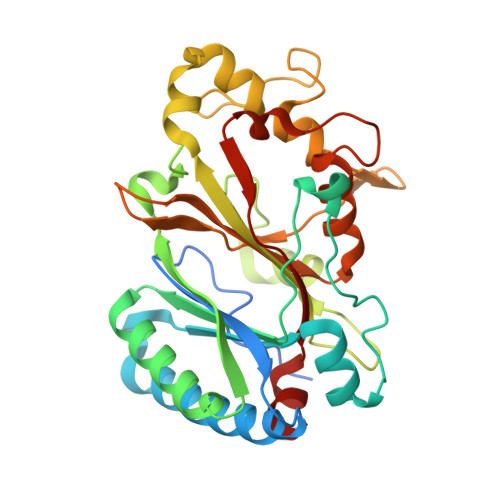Mechanistic Insights into Dye-Decolorizing Peroxidase Revealed by Solvent Isotope and Viscosity Effects.
Shrestha, R., Huang, G., Meekins, D.A., Geisbrecht, B.V., Li, P.(2017) ACS Catal 7: 6352-6364
- PubMed: 29308295
- DOI: https://doi.org/10.1021/acscatal.7b01861
- Primary Citation of Related Structures:
5VJ0 - PubMed Abstract:
Dye-decolorizing peroxidases (DyPs) are a family of H 2 O 2 -dependent heme peroxidases, which have shown potential applications in lignin degradation and valorization. However, the DyP kinetic mechanism remains underexplored. Using structural biology and solvent isotope (sKIE) and viscosity effects, many mechanistic characteristics have been uncovered for the B-class El DyP from Enterobacter lignolyticus . Its structure revealed that a water molecule acts as the sixth axial ligand with two channels at diameters of ~3.0 and 8.0 Å leading to the heme center. A conformational change of ERS * to ERS, which have identical spectral characteristics, was proposed as the final step in DyPs' bisubstrate Ping-Pong mechanism. This step is also the rate-determining step in ABTS oxidation. The normal KIE of wild-type El DyP with D 2 O 2 at pH 3.5 suggested that cmpd 0 deprotonation by the distal aspartate is rate-limiting in the formation of cmpd I, which is more reactive under acidic pH than under neutral or alkaline pH. The viscosity effects and other biochemical methods implied that the reducing substrate binds with cmpd I instead of the free enzyme. The significant inverse sKIEs of k cat / K M and k ERS* suggested that the aquo release in DyPs is mechanistically important and may explain the enzyme's adoption of two-electron reduction for cmpd I. The distal aspartate is catalytically more important than the distal arginine and plays key roles in determining DyPs' acidic pH optimum. The kinetic mechanism of D143H- El DyP was also briefly studied. The results obtained will pave the way for future protein engineering to improve DyPs' lignolytic activity.
Organizational Affiliation:
Department of Chemistry, Kansas State University, Manhattan, KS, 66506, USA.















